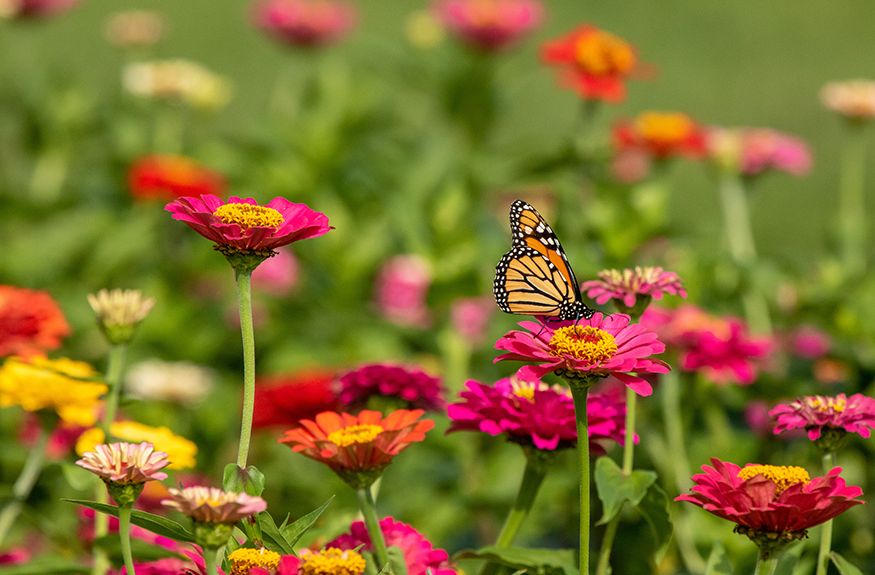Pollinator Friendly Tips for Building Owners and Managers
For the past few years, there has been an ongoing conversation about the importance of pollinators to the health of ecosystems and biodiversity. Commercial real estate industry stakeholders have a unique opportunity to implement ways to support these vital species.
Honeybees are well known pollinators that aid plant growth but butterflies, moths, hummingbirds, and more also aid in plant cultivation. According to the USDA, more than 100 United States’ crops rely on pollinators. In an average diet, one in every three bites of food required a pollinator’s help.
Plant Pollinator Friendly Vegetation
Native species are a great way to plant vegetation that attracts pollinators. Being intentional about planting native species that are beneficial to pollinators is not only helpful to biodiversity but also cost effective. Native plants use less water, pesticides, and fertilizers and require little maintenance, thus saving money. Some non-native plants can also be useful in attracting pollinators depending on the species.
Plant a Variety of Species
Pollinators are known to have distinct color preferences so planting a variety of native species with a diversity of colors will help attract pollinators and create a balanced habitat. In the Southeastern United States, wildflowers such as Golden Alexander and Butterfly Milkweed are native to this region and are pollinator friendly. In the Pacific Northwest, native flowering plants such as Selfheal and Large-Flowered Collomia are perfect for attracting pollinators. In the Midwest region, Pale Purple Coneflowers and Wild Geranium are ideal for pollinators. In some instances, it may also be beneficial to plant native and non-native species that can co-exist.
Use Less Pesticides
Pesticides with harsh chemicals can be harmful to pollinators and can potentially drive them away from a property entirely. Specifically, pesticides like organophosphates and pyrethroids, commonly used to combat mosquito infestations can be lethal to honeybees. Instead, opt for a more diluted and less harmful spray with a vinegar or oil-base.
Make a Monarch Waystation
Monarch waystations are monarch habitats designed to be a resting point while monarch butterflies migrate. A monarch waystation is simple to set up and operate in an urban area. According to the Monarch Watch organization, monarch waystations can be as simple as planting monarch resources like Milkweeds or nectar plants like Goldenrods, Butterfly Bush, Lilac, and more. Monarch waystations can also be a food source for other pollinators like honeybees.
Consider an Urban Beehive
In urban areas, beehives can be accommodated in multiple ways. Bee Downtown is an organization that maintains and installs honey beehives on corporate buildings. Bee Downtown offers educational programs for employees and all the honey collected from a hive belongs to the corporate building to be donated, gifted, and enjoyed.
“Studies show honeybees thrive in urban environments: they have reduced stressors, they’re in stable living conditions, and they have more diversity of food throughout the year” says Leigh-Kathryn Bonner, founder, and CEO of Bee Downtown.
Beehives in commercial real estate are an investment but the benefits are endless with tenant engagement, LEED certifications, environmental impact, and more.
Overall, engaging in just a few of these recommendations can have a large impact on the environmental health of your property. Whether you choose to set up pollinator friendly habitats, plant native vegetation, or are more intentional about what pesticides are used, you are making your property more pollinator friendly.
To stay up to date on news and resources such as this and other topics of importance to the real estate industry, subscribe to the free CRE Insight Journal Newsletter using this link.
Sources:
- Insects & Pollinators | NRCS (usda.gov)
- What’s so great about native plants? | EMSWCD
- Landscaping for Pollinators – MOP Boley Real Estate
- Bee Downtown (bee-downtown.com)
- Pesticides, Pollinators, and Pestilence: Protecting Public Health and Pollinators | U.S. Geological Survey (usgs.gov)
- 5 Best Pollinator Plants For The Midwest | LandscapeArchitectural.com
- Leigh-Kathryn Bonner, Bee Downtown Founder and CEO









